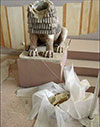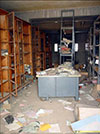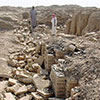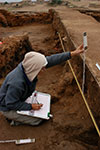Exhibit Summary
Since the invasion of 2003, the devastation in Iraq has been staggering. We are all deeply concerned about the human suffering of the Iraqi people and the well-being of our friends and colleagues in Iraq. As archaeologists and citizens, we are also alarmed by the continuing destruction of Iraq’s cultural heritage. The 2003 looting of the Iraq National Museum in Baghdad was widely reported, but the ongoing and large-scale looting of archaeological sites throughout Iraq is an even greater threat to Iraq’s cultural heritage. In the ancient past Iraq was the birthplace of cities, writing, and the wheel. Iraq continued to be a center of world civilization as the homeland of the Sumerian, Assyrian, and Babylonian empires, and the capital of the early Islamic Abbasid empire. This irreplaceable loss of Iraq’s cultural heritage is a loss to us all.
McGuire Gibson
Professor of Mesopotamian Archaeology, Oriental Institute
University of Chicago (exhibit co-curator)
Katharyn Hanson
Mesopotamian Archaeology PhD program
University of Chicago (exhibit co-curator)
Geoff Emberling
Museum Director, Oriental Institute
University of Chicago
The Museum
In April 2003, the world was shocked by the looting of the Iraq National Museum in Baghdad. The looting triggered an outpouring of anger and concern for the safety of the museum, which houses the world’s largest and most complete collection of ancient Mesopotamian artifacts, as well as documentation for all past archaeological excavations in Iraq.
The Iraq National Museum Prepares for Invasion
Prior to the 2003 Iraq war, various scholars and organizations warned of the potential damage to Iraq’s cultural heritage. The Iraq National Museum staff took steps to safeguard the collection. Manuscripts and archives were placed in an underground bunker while other valuable artifacts were sealed in the vaults of the Central Bank in Baghdad. Museum staff removed smaller artifacts from the public galleries to a secure secret location. Unfortunately, objects too heavy or difficult to remove remained in the galleries.
The Iraq National Museum in April 2003




Despite the staff’s efforts, the Iraq National Museum suffered significant looting. On April 10, 2003, just two days after U.S. troops entered the city, looters broke into the unprotected museum. Some of the looters were professional thieves who stole specific artifacts from the storerooms. A second group of looters stole artifacts from the galleries and storerooms. They also ransacked the museum’s archives, offices, and laboratories. On April 12, museum staff drove the looters out and four days later, U.S. forces secured the building. Starting April 22, Col. Matthew Bogdanos led the U.S. investigation of the looting at the museum while museum staff began the enormous tasks of assessing the damage, recovering and restoring objects.
“I have warned you because I am sure that if anything happens, then the museum will be targeted.”
—Donny George; Former Director, Iraq National Museum; February, 2003
” … it’s the same picture of some person walking out of some building with a vase, and you see it twenty times, and you think, “My goodness, were there that many vases?” (Laughter) Is it possible that there were that many vases in the whole country?”
Donald Rumsfeld; Former Secretary of Defense; April, 2003
Archaeological And Cultural Heritage Sites In Iraq
Thousands of archaeological and cultural heritage sites exist in Iraq. These sites, which document the rise of Mesopotamian civilization as well as later Islamic history, are under constant threat from looting and ongoing violence in Iraq.
Looting of archaeological sites in Iraq
Prior to the 2003 war in Iraq, the Iraq State Board of Antiquities and Heritage discouraged looting by employing site guards and sponsoring official excavations. As the 2003 invasion of Iraq drew near, excavations were halted and looters drove site guards away. Without adequate weaponry and manpower, guards were unable to prevent the wholesale destruction of many archaeological sites. Small and large sites across Iraq are now pockmarked with looters’ pits. Iraqi archaeologists are well aware of the problem, yet they can do little to prevent the looting of sites in Iraq’s current security situation.
Destruction of cultural heritage sites in Iraq

The destruction of Iraq’s past is not limited to ancient archaeological sites. Cultural heritage sites such as shrines and mosques that are a part of daily life in Iraq have also sustained substantial damage. Shrines and mosques from the Abbasid (AD 750-1258) to the Ottoman (AD 1534--1918) periods have been targeted in sectarian violence. Several cultural heritage sites and archaeological sites have also been damaged by U.S. military and Iraqi police construction projects.
“Looters systematically destroy the remains of this civilization in their tireless search for sellable artefacts. [This] ancient [city]— if properly excavated—could have provided extensive new information concerning the development of the human race.”
Joanne Farchakh-Bajjaly; Archaeologist and journalist; September, 2007
Looted Artifacts
The artifacts most vulnerable to theft are those that are the most commercially desirable. In Iraq, looters target cylinder seals and tablets with cuneiform writing because collectors value them. These stolen artifacts typically end up in New York, London, or Geneva through a developed network of illicit trade. The market for antiquities is huge, and in recent years the financial value of ancient Mesopotamian artifacts has increased dramatically. The largest share of these illicit profits goes to art dealers. A looter in Iraq receives very little.
Stolen artifacts and American museums
Stolen artifacts may end up in museum display cases, since in the United States any object held in a private collection can be donated to a museum for a tax deduction. This financial encouragement increases interest in collecting, thereby driving the prices and profits for stolen artifacts higher, which in turn causes more looting. Some museums actively encourage donations while they avoid questioning the artifacts’ origins. In contrast, many archaeological museums, such as the Oriental Institute, have strict policies against purchasing antiquities.
Artifacts and weapons on the black market

In Iraq, the sale of looted artifacts and the sale of illegal weapons are linked; the profits from selling looted artifacts buy weapons. As the current Iraq war enters its fifth year, the black-market networks for illicit trade in Iraqi antiquities have grown even more powerful. The continued looting of antiquities and their sale in other countries directly contributes to the cycle of Iraq’s internal violence.
“The looters have had time to organize their trade network and build up international clientele. They are powerful and armed.”
Donny George; Former Director, Iraq National Museump; 2003
“I know that millions of dollars’ worth of antiquities flow out of the country each year. And it would be naive to think the insurgents aren’t getting a major share of the loot.”
Matthew Bogdanos; U.S. Marine Corps Colonel who led U.S. investigation into the looting of the Iraq National Museum; March, 2007
The Importance Of Archaeological Context

Looting at ancient sites destroys archaeological context. “Archaeological context” is the location where an artifact was found, the material surrounding that artifact, and its relationship to other objects. In a controlled scientific archaeological excavation, context is identified and carefully recorded. When an artifact is looted, it is ripped out of its context and loses most of its potential archaeological and cultural information. Context gives an artifact its story; it ties one object into the larger history of an ancient building, neighborhood, city, and even an entire region. Looters’ pits destroy the architecture of ancient sites, the associations between these architectural remains and artifacts, and the relationship between different types of artifacts. Statues, tablets, or cylinder seals all may be beautiful objects on their own, but archaeological context tells us a great deal more about what they meant and how they were used than we could possibly infer from the isolated objects themselves.
“Excavated objects have a story. Looted objecs have a price tag. I ask you—which one is worth more?”
Clemens Reichel; Research Associate, Oriental Institute, University of Chicago; 2007
What Has Been Done? What Can Be Done? The Response

The world continues to be shocked by the looting of the Iraq National Museum and by the ongoing destruction of archaeological sites in Iraq. Yet the destruction of cultural heritage is not restricted to Iraq. Archaeological sites across the world are threatened by looters who are motivated by quick profits from the sale of antiquities. Each artifact wrenched from its archaeological context—whether in the southwest U.S., from Chinese burial mounds, Mesoamerican temple sites, or the Italian countryside—is another loss to our deeper understanding of our shared origins. Archaeological sites throughout the world are imperiled by looters who feed the illicit art market and in the process erase human history.
“It is my hope that the US will soon join the other countries of the world in ratifying the 1954 Hague convention. Change comes about through the active involvement of large numbers of people and those who care about cultural heritage should make their voices heard.”
Patty Gerstenblith; Professor of Law, DePaul University; 2007
The Oriental Institute Museum is located at 1155 East 58th Street, Chicago. The Museum is open Tuesday, Thursday through Saturday from 10 a.m. to 6:00 p.m., Wednesday from 10:00 a.m. to 8:30 p.m., and Sunday from noon to 6:00 p.m. Suggested donation for admission is $5 for adults, $2 for children. For information, call (773) 702-9514.

